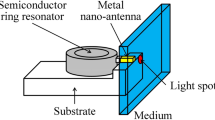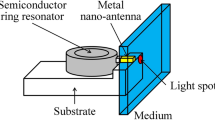Abstract
Heat-assisted magnetic recording (HAMR) is a promising technology for improving the recording density of hard disk drives. A near-field transducer (NFT), which forms a small light spot on a recording medium, is necessary in HAMR. The authors’ group previously proposed a device, in which a metal nano-antenna acting as an NFT is attached to a semiconductor ring resonator acting as a laser. There are TE- and TM-like modes in the ring resonator. Because a near-field light is generated at the tip of nano-antenna only in TE-like mode, how to excite TE-like mode selectively is an important issue. In this study, a numerical simulation considering gain was conducted to investigate whether a double-ring-resonator-type device is effective for improving the mode selectivity between TE- and TM-like modes. The size of the ring resonators was determined so that the resonance frequency of each ring resonator was almost the same for TE-like mode and slightly different for TM-like mode. The double-ring-resonator-type device was found to be effective for making the laser oscillation with TE-like mode more dominant than with TM-like mode. The size of the smaller ring resonator should not be too small to secure practical manufacturing tolerance. Moreover, both ring resonators should have gain to obtain adequate gain for each mode and energy density at the tip of nano-antenna simultaneously.












Similar content being viewed by others
Data availability
Data sets generated during the current study are available from the corresponding author on reasonable request.
References
Weller, D., Moser, A.: Thermal effect limits in ultrahigh-density magnetic recording. IEEE Trans. Magn. 35, 4423 (1999)
Kryder, M.H., Gage, E.C., McDaniel, T.W., Challener, W.A., Rottmayer, R.E., Ju, G., Hsia, Y.-T., Erden, M.F.: Heat assisted magnetic recording. Proc. IEEE 96, 1810 (2008)
Challener, W.A., Peng, C., Itagi, A.V., Karns, D., Peng, W., Peng, Y., Yang, X., Zhu, X., Gokemeijer, N.J., Hsia, Y.-T., Ju, G., Rottmayer, R.E., Seigler, M.A., Gage, E.C.: Heat-assisted magnetic recording by a near-field transducer with efficient optical energy transfer. Nat. Photonics 3, 220 (2009)
Stipe, B.C., Strand, T.C., Poon, C.C., Balamane, H., Boone, T.D., Katine, J.A., Li, J.-L., Rawat, V., Nemoto, H., Hirotsune, A., Hellwig, O., Ruiz, R., Dobisz, E., Kercher, D.S., Robertson, N., Albrecht, T.R., Terris, B.D.: Magnetic recording at 1.5 Pb m-2 using an integrated plasmonic antenna. Nat. Photonics 4, 484 (2010)
Katayama, R., Sugiura, S.: Simulation on near-field light generated by a semiconductor ring resonator with a metal nano-antenna for heat-assisted magnetic recording. Jpn. J. Appl. Phys. 58, SKKB01 (2019)
Katayama, R., Sugiura, S.: Three-dimensional simulation on near-field light generated by semiconductor ring resonator with metal nano-antenna for heat-assisted magnetic recording. Proc. SPIE 11125, 1112506 (2019)
Kawazoe, T., Kobayashi, K., Ohtsu, M.: Optical nanofountain: a biomimetic device that concentrates optical energy in a nanometric region. Appl. Phys. Lett. 86, 103102 (2005)
Chen, J., Katayama, R., Sugiura, S.: Simulation on parameter optimization of semiconductor ring resonator with nano-antenna for heat-assisted magnetic recording device. Opt. Rev. 28, 681 (2021)
Oda, K., Takato, N., Toba, H.: A wide-FSR waveguide double-ring resonator for optical FDM transmission systems. J. Lightwave Technol. 9, 728 (1991)
Ja, Y.H.: Vernier operation of fiber ring and loop resonators. Fiber Integr. Opt. 14, 225 (1995)
Wei, L., Lit, J.W.Y.: Compound ring resonator with double couplers. Opt. Commun. 186, 283 (2000)
Shang, L., Liu, L., Xu, L.: Single-frequency coupled asymmetric microcavity laser. Opt. Lett. 33, 1150 (2008)
Chen, J., Katayama, R., Sugiura, S.: Simulation on double semiconductor ring resonators with nano-antenna for HAMR device. Tech. Dig. ISOM’21 Su-B-02 (2021)
Katayama, R., Sugiura, S.: Simulation on double-ring-resonator-type device considering gain for heat-assisted magnetic recording. Tech. Dig. ODF’22 P-OTh-41 (2022)
Palik, E.D. (ed.): Handbook of Optical Constants of Solids, Vol. I, Part II. Academic Press, London (1985)
Hawkins, R.J., Kallman, J.S.: Lasing in tilted-waveguide semiconductor laser amplifiers. Opt. Quantum Electron. 26, S207 (1994)
Acknowledgements
This work was supported by JSPS KAKENHI Grant Number JP19K04541.
Author information
Authors and Affiliations
Corresponding author
Additional information
Publisher's Note
Springer Nature remains neutral with regard to jurisdictional claims in published maps and institutional affiliations.
Rights and permissions
Springer Nature or its licensor (e.g. a society or other partner) holds exclusive rights to this article under a publishing agreement with the author(s) or other rightsholder(s); author self-archiving of the accepted manuscript version of this article is solely governed by the terms of such publishing agreement and applicable law.
About this article
Cite this article
Katayama, R., Chen, J. & Sugiura, S. Simulation on double-ring-resonator-type device considering gain for heat-assisted magnetic recording. Opt Rev 30, 361–375 (2023). https://doi.org/10.1007/s10043-023-00805-z
Received:
Accepted:
Published:
Issue Date:
DOI: https://doi.org/10.1007/s10043-023-00805-z




